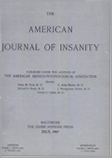PROLONGED NARCOSIS AS THERAPY IN THE PSYCHOSES
Abstract
We have had an opportunity to observe the patients treated by this method for periods varying from 2 years to 10 months. The majority of treatments were given two years ago so that the results obtained may be said to have been subjected to a reasonable test of time.
Toxic effects evidenced by the "barbital rash," vomiting, fever, etc., were frequently noted during the administration of luminal and sodium luminal. These reactions together with marked hyperpyrexia and chills induced by intravenous injections of typhoid vaccine seemed to result in an unjustifiable degree of prostration and in several instances appeared to jeopardize the physical welfare of the patient. No deaths occurred during the treatment of this series of patients though fatalities are not infrequent in the reports of European investigators, who have employed this method of therapy.
Sodium amytal has not, in our experience, produced any toxic effects even though doses of 40 to 60 grains in 24 hours have been average and 90 to 120 grains not uncommon. Repeated checks on kidney function during the treatment have rarely shown the presence of albuminuria. Kidney function tests taken after as compared to before the sodium amytal narcosis fail to reveal any interference in rate of secretion.
Used in the doses mentioned sodium amytal has never failed to produce the desired degree of narcosis. From time to time tolerance to the drug seemed to develop but has never been of enough significance to interfere with the treatment. The rate of injection for intravenous administration should not exceed 1 cc. per minute and we have found it advisable to regulate the rate of injection by stop watch. A fall of systolic blood pressure of from 10 to 40 mm. of mercury is almost constant. If the rate of injection is hastened the fall of blood pressure is correspondingly greater and more precipitate. A 10 per cent solution was first employed but caused sclerosis of smaller veins with the formation of thrombi. A 5 per cent solution is now used and no outward effects have been noted. When administered intramuscularly, rectally, or orally the results have been almost as satisfactory as by intravenous technique, though considerably slower.
None of the barbitals used thus far have been in any way habitforming and no withdrawal symptoms have been noted.
Calculation of dosage according to body weight would seem more accurate but is not practicable since the requirements of patients seem to vary with the type of psychotic reaction and not with weight, age, sex, nor the degree of agitation.
A nurse at the bedside to record, verbatim, the productions of the patient during the phases of induction and emergence from the stupor is a valuable help in detecting the significant factors in the structure of the psychosis.
In ambulatory patients, private and clinic practice it has been possible by means of small doses of sodium amytal to assist uncommunicative patients to reveal their conflicts. Also, in many cases the drug seems to act as an agent facilitating the release of dreams which furnish an abundance of material on which to base conclusions as to the dynamics of the illness as well as psychotherapeutic procedures.
Access content
To read the fulltext, please use one of the options below to sign in or purchase access.- Personal login
- Institutional Login
- Sign in via OpenAthens
- Register for access
-
Please login/register if you wish to pair your device and check access availability.
Not a subscriber?
PsychiatryOnline subscription options offer access to the DSM-5 library, books, journals, CME, and patient resources. This all-in-one virtual library provides psychiatrists and mental health professionals with key resources for diagnosis, treatment, research, and professional development.
Need more help? PsychiatryOnline Customer Service may be reached by emailing [email protected] or by calling 800-368-5777 (in the U.S.) or 703-907-7322 (outside the U.S.).



